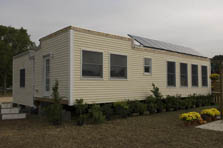

The University of Massachusetts Dartmouth house is set up as a demonstration and solar promotional home at Mountain View Builders in Berkeley Springs, West Virginia.
(Credit: Chris Gunn, Solar Decathlon)
Solar Decathlon 2005
Campuses, Communities, Nonprofits Host Houses after the Competition
During the past two years, Solar Decathlon teams from across the United States, Canada, Puerto Rico, and Spain have worked to design, fundraise, build, transport, and finally operate their solar-powered homes at the National Mall in Washington, D.C., for the 2005 Solar Decathlon competition. Eighteen new solar-powered homes are now complete. Just where each solar home will make its final destination is an intriguing team decision of considerable interest and thought. The teams' successful negotiations for permanent locations for their entries illuminate the enduring place for solar in their communities.
Some schools have opted to donate their homes to their respective college campuses or in the community for public education purposes. Others will deliver their homes for further research opportunities. And some schools have chosen diverse community outreach projects as a final destination for their solar homes.
The University of Massachusetts Dartmouth knew from the first stages of project development that Habitat for Humanity would be the recipient of their solar-powered home. A year ago, the Dartmouth Solar Decathlon team piled into a van and headed for London County, Tennessee, over spring break. Here, they worked closely with Oak Ridge Laboratories to build the fourth high-efficiency, PV-powered Habitat for Humanity home. After the 2005 Solar Decathlon competition, the students from Dartmouth will realize their dream of designing and building a solar-powered home and delivering it to a permanent Habitat for Humanity site in Washington, D.C.
Solar Decathlon students from the University of Maryland will donate their solar home to the Red Wiggler Community Farm. The farm creates meaningful jobs for adults with developmental disabilities through the business of growing and selling vegetables. Rob Murray, student and Solar Decathlon team member says, "We were searching for a good fit. Red Wiggler Community Farm was particularly appealing because the team wanted to benefit the local Maryland community. It's a place where the youth from the community come and learn about farming. It's where our solar home will leave a lasting legacy." The University of Maryland's solar home will be particularly beneficial to Red Wiggler Farm as it will provide a staff member affordable housing and the opportunity to actually live on-site.
The University of Texas at Austin will donate their home to a low-income neighborhood in Austin. The nonprofit is partnering with the School of Architecture to rent the house to a student in exchange for design work on their other low-income properties in the neighborhood.
Other team plans include: the Pittsburgh Synergy team is bringing its entry back to the city, where it will house an environmental education center. Virginia Polytechnic Institute and State University students plan to return their house to its native state, displaying it first on campus and later at the Virginia Department of Mines, Minerals, and Energy in Richmond. Crowder College will bring its house home as well, siting it on campus near the Crowder house from the inaugural 2002 competition. And WSU formed a partnership with Seattle City Light, the city's municipal electric utility, which will allow the WSU house to take up residence in Seattle's Warren G. Magnuson Park. There it will be open to the public as an educational and training facility.
